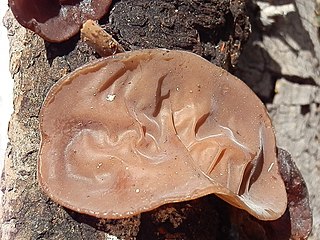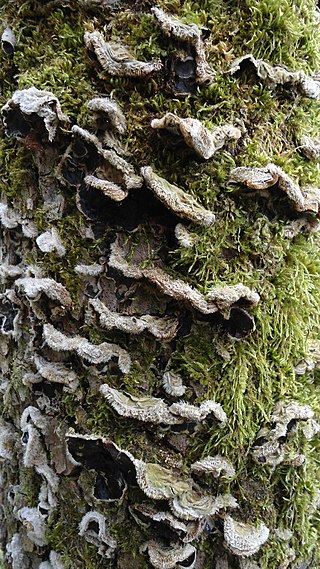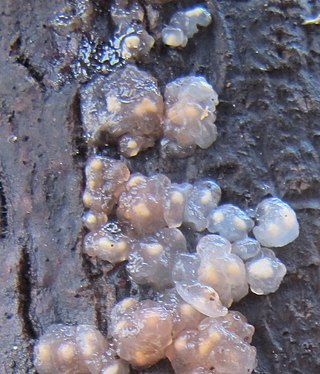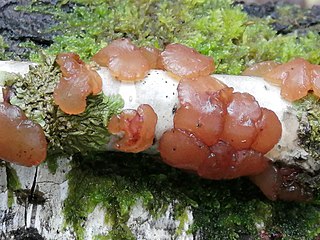
The Tremellaceae are a family of fungi in the order Tremellales. The family is cosmopolitan and contains both teleomorphic and anamorphic species, most of the latter being yeasts. All teleomorphs in the Tremellaceae are parasites of other fungi, though the yeast states are widespread and not restricted to hosts. Basidiocarps, when produced, are gelatinous.

The Auriculariales are an order of fungi in the class Agaricomycetes. Species within the order were formerly referred to the "heterobasidiomycetes" or "jelly fungi", since many have gelatinous basidiocarps that produce spores on septate basidia. Around 200 species are known worldwide, placed in six or more families, though the status of these families is currently uncertain. All species in the Auriculariales are believed to be saprotrophic, most growing on dead wood. Fruit bodies of several Auricularia species are cultivated for food on a commercial scale, especially in China.

The Tremellales are an order of fungi in the class Tremellomycetes. The order contains both teleomorphic and anamorphic species, most of the latter being yeasts. All teleomorphic species in the Tremellales are parasites of other fungi, though the yeast states are widespread and not restricted to hosts. Basidiocarps, when produced, are gelatinous.

The Hyaloriaceae are a family of fungi in the order Auriculariales. Species within the family have gelatinous basidiocarps that produce spores on septate basidia and, as such, were formerly referred to the "heterobasidiomycetes" or "jelly fungi". All appear to be saprotrophic, growing on dead wood or plant remains. Less than 30 species are currently included within the Hyaloriaceae, but the family has not been extensively researched.

Auricularia is a genus of fungi in the family Auriculariaceae. Basidiocarps are typically gelatinous and ear-shaped, with a slightly downy to conspicuously hirsute upper surface and an under surface that is smooth, wrinkled or veined. All species grow on wood. Several Auricularia species are edible and commercially cultivated on a large scale in China and East Asia.

Exidia is a genus of fungi in the family Auriculariaceae. The species are saprotrophic, occurring in attached or recently fallen dead wood, and produce gelatinous basidiocarps. The fruit bodies are diverse, pustular, lobed, button-shaped or cup-shaped. Several species, including the type species Exidia glandulosa, have sterile pegs or pimples on their spore-bearing surface. The genus has a cosmopolitan distribution and around 20 species are currently recognized worldwide. Initial molecular research indicates the genus is artificial.

Exidia recisa is a species of fungus in the family Auriculariaceae. In the UK, it has the recommended English name of amber jelly. Basidiocarps are gelatinous, orange-brown, and turbinate (top-shaped). It typically grows on dead attached twigs and branches of willow and is found in Europe and possibly elsewhere, though it has long been confused with the North American Exidia crenata.

Myxarium nucleatum is a species of fungus in the family Hyaloriaceae. In the UK, it has been given the recommended English name of crystal brain. Basidiocarps are watery white, pustular or lobed, and gelatinous with small, white, mineral inclusions visible to the naked eye. It is a common, wood-rotting species in Europe, typically growing on dead attached or fallen branches of broadleaf trees. It is currently not clear whether collections from North America and elsewhere represent the same species.

Auricularia auricula-judae, commonly known as wood ear, jelly ear, or more historically, Jew's ear, is a species of fungus in the order Auriculariales. Basidiocarps are brown, gelatinous, and have a noticeably ear-like shape. They grow on wood, especially elder. The specific epithet is derived from the belief that Judas Iscariot hanged himself from an elder tree.
Colacogloea is a genus of fungi belonging to the class Microbotryomycetes. Most species in the genus are known only from their yeast states. Where known, basidiocarps have auricularioid basidia and occur as parasites on or in the fruit bodies of other fungi.

Auricularia americana is a species of fungus in the family Auriculariaceae. Basidiocarps (fruitbodies} are gelatinous, ear-like, and grow on dead conifer wood. The species was formerly confused with Auricularia auricula-judae, which grows on broadleaf wood and is confined to Europe.

Auricularia angiospermarum is a species of fungus in the family Auriculariaceae. Basidiocarps (fruitbodies) are gelatinous, ear-like, and grow on dead wood of broadleaf trees. It is a North American species and was formerly confused with Auricularia auricula-judae which is confined to Europe.

Auricularia mesenterica, commonly known as the tripe fungus, is a species of fungus in the family Auriculariaceae. Basidiocarps are gelatinous and typically formed in coalescing tiers on stumps and logs. They are partly pileate, with hirsute, zoned caps, and partly resupinate, with smooth to wrinkled undersurfaces that spread over the wood. Auricularia mesenterica is a saprotroph on dead deciduous trees and shrubs. The species is restricted to Europe and Central Asia.

Myxarium is a genus of fungi in the family Hyaloriaceae. Basidiocarps are gelatinous and effused or pustular. The genus is cosmopolitan. All species grow on dead wood or dead herbaceous stems.

Tremellochaete is a genus of fungi in the family Auriculariaceae. Species produce pustular or lobed, effused, gelatinous basidiocarps on wood, typically covered in small sterile spines or pegs.
Platygloea is a genus of fungi belonging to the class Pucciniomycetes. Basidiocarps of the type species are disc-shaped, gelatinous, and occur on dead wood, probably as a saprotroph. Microscopically, all species of Platygloea sensu lato have auricularioid basidia. Currently the genus contains a heterogeneous mix of auricularioid fungi not yet accommodated in other genera.
Cystobasidium fimetarium is a species of fungus in the order Cystobasidiales. It is a fungal parasite forming small gelatinous basidiocarps on various ascomycetous fungi on dung. Microscopically, it has auricularioid basidia producing basidiospores that germinate by budding off yeast cells. The species is known from Europe and North America.

Exidia repanda is a species of fungus in the family Auriculariaceae. In the UK, it has the recommended English name of birch jelly. Basidiocarps are gelatinous, orange-brown, and button-shaped. It typically grows on dead attached twigs and branches of birch and has been recorded from Europe, North America, and Japan.
Exidia umbrinella is a species of fungus in the family Auriculariaceae. Basidiocarps are gelatinous, orange-brown, and turbinate (top-shaped). It grows on dead attached twigs and branches of conifers in Europe.
Hirneolina is a genus of fungi in the order Auriculariales. Basidiocarps are effused, waxy, and occur on dead wood. Only the type species, described from Ecuador and reported from Brazil, is currently confirmed as belonging to the genus.















